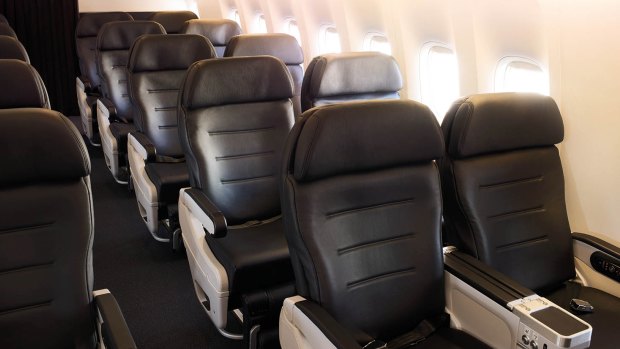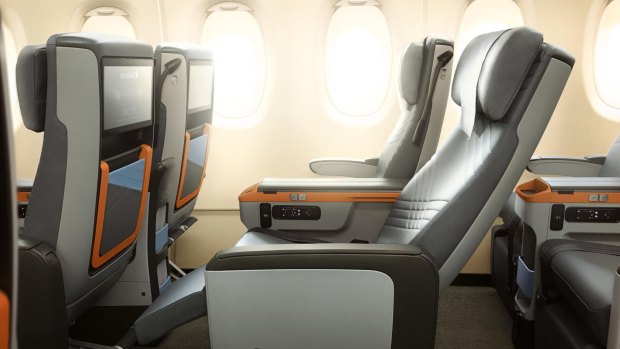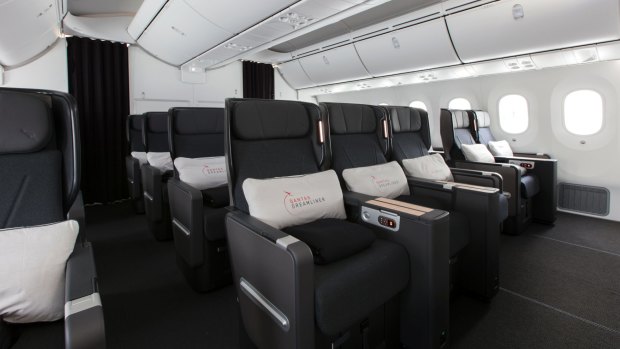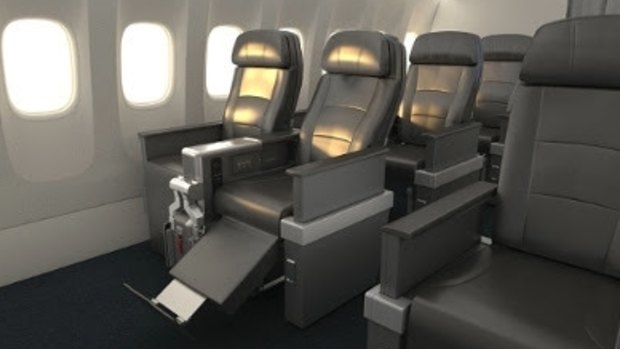This was published 5 years ago
Price of premium economy on airlines versus economy: Why airlines love premium
By Justin Bachman

Air New Zealand's premium economy cabin was named the world's best at the 2018 World Airline Awards.
Travellers probably won't be rushing to praise the airlines for it, but industry investors should find a lot to love in an innovation that offers just a smidgen more wiggle room for twice the money.
As budget economy class seats become more cramped, and business class gets more luxurious and pricey, demand has swelled for an in-between option that will give flyers a little more comfort without breaking the bank on long overseas flights. That's how the "premium- economy" seats offered in a growing percentage of international jet fleets have become one of the most lucrative innovations in modern flying.
Travellers pay prices that are broadly double -- and sometimes triple -- economy fares. And here's the brilliant part from an airline's perspective: In adding this cash-generating cabin, they incur only modestly higher costs without siphoning affluent travellers from their posher cabins. US airlines are rushing to add the offering, which was pioneered by international rivals.

Singapore Airlines' premium economy.
"Anytime you can get paid double for something that doesn't cost you double to produce, that's a pretty good place to be for any company," said Seth Kaplan, editor of trade journal Airline Weekly, noting that the premium cabin "doesn't take up twice the real estate, the food doesn't cost twice as much."
Premium Perks
The premium-economy cabin, pioneered in the early 1990s in Taiwan and the UK, typically offers wider seats with more legroom, nicer meal service and larger video screens. The option has become a must-have for long-haul international carriers because of passenger demand and the profit it generates above regular economy seats.

"This is really tapping into unmet demand that has been sitting in the economy cabin for some years," says Phil Capps of Qantas.Credit: Brent Winstone
The push for premium economy is also getting a boost from the revenue limitations of the swankier seats in first and business class. Those plusher berths aren't the most reliable cash generators for big international airlines because so many of them are consumed by loyalty-program upgrades.
Meanwhile at the other end of the airplane, in back, the spread of ultra low-cost airlines into long-haul flying has pinched industry income from economy fares.
A round-trip American Airlines nonstop flight from Los Angeles to London flying Nov 14-21, was priced at $US1791.41 ($A2528)in premium economy -- nearly triple the economy fare of $US577 on the same trip.

American was the first US carrier to introduce premium economy in late 2016 on its 787-9 Dreamliners.
A premium seat on a Delta Air Lines nonstop from Detroit to Tokyo for those dates was $US2803.41 -- $US1602 more than the economy fare. On Qantas, the gap between the two cabins was more than $US2000 for its Dallas-Sydney nonstop flight, which was $US3673 round-trip in premium economy.
In the other direction, a flight from Sydney to Dallas was $A5003 in premium economy versus just $A1200 in economy class.
Even with that markup, premium-economy fares remain thousands cheaper than business and first class.
Highest Profit
On some network airlines, the premium-economy cabin probably commands the highest profit margins on the entire aircraft, said Jude Bricker, chief executive officer of Sun Country Airlines Inc., which designates 27 seats as premium economy on its Boeing 737s. "This is all about giving people what they are willing to pay for," he said.
Early next year, United Continental will become the third major US carrier, after Delta and American, to offer a premium-economy cabin. Emirates, the world's largest airline by international traffic, plans to have it in 2020.
American was the first US carrier to introduce the new cabin feature in late 2016 on its 787-9 Dreamliners. It plans to offer the seating on 124 long-haul planes by mid-2019. In testament to the cabin's earning power, American is yanking eight business-class seats from its 20 Boeing 787-8s to replace them with 28 new premium-economy seats.
Premium Branding
Delta will have comparable "Premium Select" seats on its full wide-body fleet by 2021, including 18 of its 777-200 jets by the end of next year.
United currently has 24 premium-economy seats flying on six Boeing 777s, but is still developing the amenities it will offer on a full "Premium Plus" product to debut early next year.
"It has the potential to be a fantastic product for the airline and our customers and our shareholders, but we're at early days," Andrew Nocella, United's chief commercial officer, said in an interview, calling the carrier "anxious to catch up" with other airlines flying the cabin. The carrier is still trying to determine the ideal mix of economy, premium-economy and business-class seating for each aircraft and region, he said.
"Getting that calculation correct so you can size each cabin appropriately is fundamental," said Nocella, a former American executive who was involved in that airline's decision to add the new cabins. Both carriers use Rockwell Collins Inc.'s MiQ seat for their premium-economy sections, which is also used in American's business class on some Airbus single-aisle aircraft.
'Unmet Demand'
Flights over 14 hours offer the best opportunity to provide multi-leveled products to serve customers, said Phil Capps, head of customer experience at Qantas, which began selling premium economy a decade ago with the arrival of its first Airbus A380s. "This is really tapping into unmet demand that has been sitting in the economy cabin for some years," he said.
Premium economy dates to 1992 when EVA Airways and Virgin Atlantic introduced it within months of each other.
The new cabin "was just kind of inevitable" as many international airlines phased out first class and made business-class cabins more luxurious, while steerage sections became increasingly austere, Airline Weekly's Kaplan said. Given the opulence in the front of modern long-haul airplanes, including such accouterments as flat beds, gourmet dining, lush bedding and extravagant wines and liquors, "What used to be business class is now called premium economy," he said.
Growth Outlook
Moreover, premium economy represents a growth opportunity for North American carriers since the product is still a novelty in the US and Canada. Premium-economy bookings jumped 78 percent in North America between 2015 and 2017, but dipped 13 percent globally, led by declines in Europe and the Middle East, according to booking data from Carlson Wagonlit Travel.
The cabin can also help airlines reserve business and first class for their very top customers by offering another upgrade option to those in economy, Kaplan said. Even so, the inventory is likely to be tightly restricted for people who are cashing in miles. The premium-economy cabins "are not there to help people with miles, they're there to generate cash," he said.
Business and first-class cabin performance is flat globally, accounting for 31 percent of passenger revenues and 5.1 percent of traffic in the first half of this year, unchanged from the same period of 2017, according to the International Air Transport Association.
Premium economy's growth will be fuelled by both leisure travellers looking for something more comfortable than standard economy, and by businesses that won't pay for first class anymore but may be willing to ante up for a premium-economy seat, said Perry Flint, a spokesman for IATA, a trade group representing airlines.
"Only around a quarter of our clients have policies that explicitly allow their travellers to book this cabin class, suggesting that there's still a lot of room for growth for premium economy in corporate travel," said Michael Valkevich, a Carlson Wagonlit senior director in Singapore.
The best premium economy cabins for 2018
- Air New Zealand (Read our full review)
- Qantas Airways (Review)
- Singapore Airlines (Review)
- Lufthansa
- Air France
- Aeroflot
- EVA Air
- Japan Airlines (Review)
- Virgin Australia (Review)
- China Airlines
- ANA All Nippon Airways (Review)
- Air Canada (Review)
- Cathay Pacific Airways (Review)
- Virgin Atlantic
- Alitalia
- Austrian Airlines
- British Airways (Review)
- Iberia
- American Airlines
- SAS Scandinavian
Source: World Airline Awards
Bloomberg
See also: Is premium economy worth it? What you get for the money
See also: World's best airline for 2018 named
Sign up for the Traveller newsletter
The latest travel news, tips and inspiration delivered to your inbox. Sign up now.